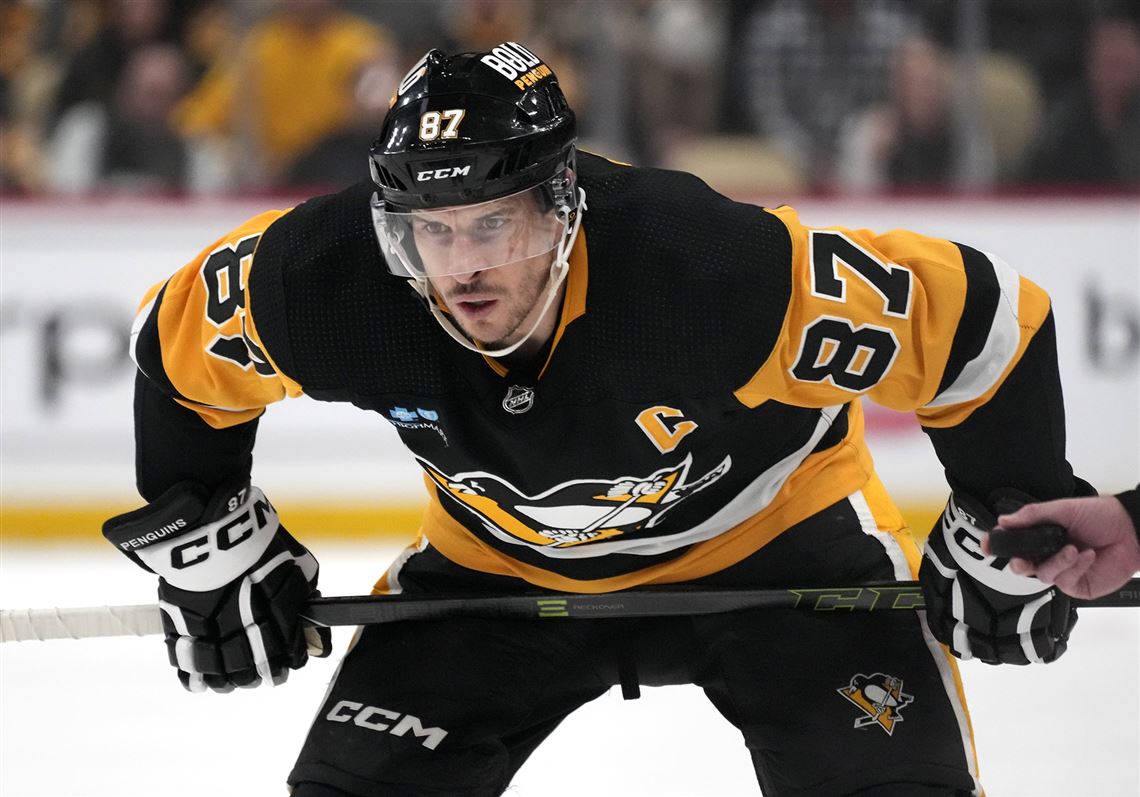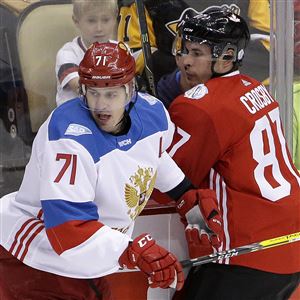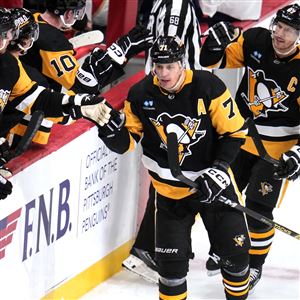When the video montage plays at Sidney Crosby’s Hockey Hall of Fame induction ceremony, it will feature jaw-dropping plays — ones like a spinning back-hand assist to Jake Guentzel in the Penguins’ latest win.
What’s less likely to make the cut is Crosby’s work on the forecheck. On Jan. 2, the captain crunched Capitals defenseman Rasmus Sandin behind Washington’s goal, stole the puck and delivered a perfect pass to Guentzel at the net front — all within four seconds.
It isn’t just offensive excellence that has allowed Crosby to secure a 10th selection to the NHL All-Star Game. Though he is on track to score his second-most goals (48) in a season, Crosby remains committed to playing an elite two-way game that, in his 19th campaign, is a non-negotiable part of the job.
“As a center, you have to,” Crosby said. “It kind of comes with the territory.”
NHL greats Steve Yzerman, Sergei Fedorov and Mike Modano are among the few centermen who excelled offensively early in their careers but remained effective players in their mid-to-late 30s because of their increased emphasis on defense.
Crosby has similarly changed his game, but is far exceeding their offensive production at this point in their respective careers. Should Crosby keep up at his current scoring clip, he could surpass Alex Ovechkin’s NHL-record for goals (50) in an age-36 season or later.
“Being able to get out of your zone quick, being good defensively, hopefully it leads to more time with the puck and creating offensively,” Crosby told the Post-Gazette. “I don't think it's something that necessarily means you have to take away from offense to do it.
“I think being good defensively leads to more offense.”
To play this way at 36 is a testament to Crosby’s training. It has also provided an arduous exercise for current and former players alike to come up with adequate comparisons.
“It is so rare to be this,” said Ray Ferraro, a 21-year NHL vet and current color commentator for ESPN and ABC. “This is Tom Brady-esque.”
“I think [of] the Michael Jordans, the big names out there,” said former teammate and current Carolina Hurricanes center Jordan Staal. “The Mario Lemieuxs, and the [Wayne] Gretzkys.”
Bryan Trottier, who played 18 NHL seasons and won a pair of Stanley Cups with the Penguins, was particularly stumped. That is, until he wasn’t.
“Sid’s going to be the one in a billion for me because there's no one to compare him to,” Trottier said. “There's nobody. It’s what he did at 18 and what he's doing at 36, and what he might do at 46. Who knows?
“He might be the modern-day Gordie Howe, that just goes on and on.”
Appetite for learning
Sergei Gonchar was instantly impressed with an 18-year-old Crosby’s unique blend of speed, skill and hockey IQ.
“He was the whole package,” said Gonchar, a former Penguins blue-liner. “His mind [was] in the right spot. He was pushing himself, trying to get better every day.”
However, for all of Crosby’s strengths at his young age, there were a few flaws that contributed to the minus-1 rating he posted as a rookie, second-worst of his career.
Like many young centers, Crosby struggled in the faceoff circle. He had to improve his defensive positioning, too, in acclimating to a faster game than what he was used to in junior hockey.
Crosby didn’t just wait until the end of his rookie season to improve at the dot and other aspects. Gonchar remembers Crosby diligently trying to elevate his work on draws after practices and intently watching teammates more adept at it.
“He usually picks up little details to get better and learn from everybody,” Gonchar said. “It’s how Sid is.”
Eddie Olczyk, Crosby’s first NHL coach who is now a commentator on TNT and Seattle Kraken games, quickly learned how curious a mind his then-young star possessed. Olczyk was particularly impressed by Crosby’s aptitude during video sessions, specifically toward defensive positioning.
“Before the tape would start playing, Sid would go, ‘Oh yeah, here, I probably should have stopped here and just held my position here,’” Olczyk said. “He knew even before the tape would run. That’s obviously an incredible student of the game, just knowing and being able to learn right off the bat.”
Teammates like Gonchar knew from the outset they were in the presence of a skilled talent. But for Crosby, simply being a spectacular individual in the offensive end wasn’t going to be enough.
It would take time to polish his overall game and become a more well-rounded player in both the offensive and defensive zones. Crosby’s motivation for doing so, though, was abundantly clear.
“For him, everything was about winning,” Gonchar said. “Obviously, you cannot [win] if you’re not a good defensive team. So that’s why he was working on it.”
Defensive dominance
Rumor has it Crosby is in the running for one of the few pieces of hardware that has eluded him in a decorated career: the Selke Trophy, awarded annually to the NHL’s top defensive forward. At least, that’s what Jordan Staal is hearing from people around the league.
“There's a reason why,” the former Penguins center said. “He's just hard to play against on both sides of the rink. When he has the puck, you've always seen what he can do. But when he doesn't have the puck, I think he's gotten even smarter.”
Patrice Bergeron has had a stranglehold on the Selke over the last decade, securing it a record six times dating back to the 2011-12 campaign. Crosby, meanwhile, has never finished higher in voting than fourth following the 2018-19 season.
Staal — who is no defensive slouch in his own right — can see similarities between the two.
“Every time you line up against him, you're like, ‘Oh, boy, here we go,’” Staal said. “I’ve got to make sure I'm on, because he's gonna either burn me offensively or I'm going to have to really work for my chances to get anything tonight.”
Instead of being a liability on faceoffs like he was as a rookie, Crosby has been a dominant asset for the Penguins. No player in the NHL has either taken or won more faceoffs this season than Crosby. His success rate is the highest of his career, and by a wide margin.
According to some advanced analytics, Crosby’s defensive work in other areas has slid a bit the past few seasons. But that’s more a matter of what the Penguins require from their captain on offense. Crosby is still amply capable of shutting it down when needed.
Seemingly always in the right position defensively, Crosby is knowledgeable as ever of angles and reading plays. His still-powerful lower half allows him to often win the 50-50 battles that are so critical to any team’s success. And Crosby can steal a goal or two off the forecheck, too, just as he’s done this season.
“Honestly, I don't think that you could have the conversation with Selke without having Sid as a finalist right now,” Olczyk said. “I think it would be very disappointing and surprising if he's not a finalist.”
“If I had a vote, he would be my guy right now.”
‘Sid is still there’
With the Penguins slotted at 10th place in the Eastern Conference, Crosby has a ways to go for his name to be etched on the Stanley Cup for a fourth time.
“The Penguins are a bubble team,” Olczyk said. “I don't think there's any doubt about that.”
Olczyk, along with many others, also understands that the Penguins’ inconsistencies aren’t a byproduct of their captain. Phil Bourque, a SportsNet Pittsburgh color commentator for Penguins games who won two Stanley Cup championships with the team, shuddered at the notion of where Crosby’s squad would be without him
“It would not be mathematically eliminated, but they’d almost be realistically eliminated,” Bourque said. “That's a sobering statement to make for somebody that loves the Pittsburgh Penguins as much as I do.”
More heralded young players enter the mix each season, just like Crosby once did, pushing him to maintain his standard of excellence as one of the NHL’s greats. But heading to Toronto for the midseason classic on Saturday, Crosby has proven to still be both the face of the league and one of its best players.
He and Los Angeles Kings goalie Cam Talbot are tied for the oldest player in the All-Star Game. Yet Crosby, in Year 19, remains steadfast in his eagerness to lace up his skates.
“It's not easy,” Crosby said with a wry smile. “Guys are getting better and faster. The league is so young, guys are coming in so prepared.
“There seems like there's no adjustment period for some of the young guys that have come in. It's fun to see all the skill and speed that's out there, and you just want to keep playing at a high level.”
It is impossible to predict how much longer Crosby can keep playing in such a manner, or when he will call it quits on a storied career. He has provided no public desire to retire anytime soon.
But while he continues to be one of the NHL’s top two-way players, perhaps more thoroughly appreciating Crosby at a level that’s just shy of his peak should be atop any hockey savant’s itinerary.
“Sid is still there,” Ferraro said. “Everybody talks about the shiny toy and not about the old guy anymore, nowhere near as much as we probably should.
“Consistency is boring, too. That's why I think Sid’s greatness, the 1,500-plus points and all that, it's been so remarkably consistent that it's almost like, ‘Well, what else are you going to talk about?’”
Andrew Destin: adestin@post-gazette.com and Twitter @AndrewDestin1.
First Published: February 1, 2024, 10:30 a.m.
Updated: February 1, 2024, 9:32 p.m.












